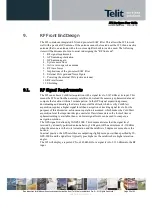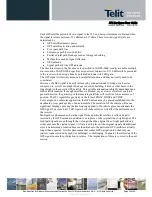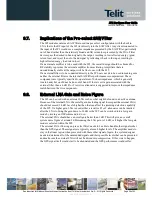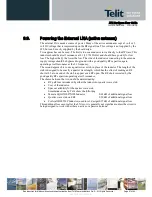
JF2 Hardware User Guide
1vv0300985 Rev.4 2013-04-09
Reproduction forbidden without written authorization from Telit Communications S.p.A. - All Rights Reserved.
Page 36 of 40
Mod. 0805 2011-07 Rev.2
The receiver can be configured to compute SBAS satellite range measurements and use them
in the navigation solution. This can be enabled through a control bit in the OSP Mode
Control command (MID 136). See the OSP Manual for details.
11.6.3.
2-D Acquisition
By default, the JF2 will compute a 2-D solution when possible when performing initial
acquisition. In a 2-D solution, the receiver assumes a value for altitude and uses it to estimate
the horizontal position. Under warm and hot start conditions, the receiver uses the last known
value of altitude, which is a good assumption in most situations.
However under cold start conditions, the last position is unknown, and the receiver assumes a
value of 0. In situations where the true altitude is significantly higher than that, the horizontal
position estimate will be noticeably impacted. To accommodate applications for which these
situations are a concern, a version of JF2 firmware is offered that requires a calculated altitude,
i.e. a 3-D navigational solution, in order for the receiver to first enter navigation.
11.6.4.
MEMS Compass Heading
The JF2 module incorporates a feature that reads and reports the compass heading from a 3-
axis magnetometer. The raw heading data is used to enhance navigation performance under
low speed conditions. The raw heading data is also reported over the OSP message interface.
The compass heading information meets the following general performance guidelines:
50% Heading Accuracy
2 Deg
95% Heading Accuracy
5 Deg
NOTE: The magnetic compass feature and performance is affected by the magnetic
environment due to magnetic anomalies. These can typically be caused by large masses of
ferrous metal, such as iron, as well as natural disturbances in the earth’s magnetic field. These
magnetic anomalies cause errors in the sensing of the magnetic field and result in larger than
specified errors.



































